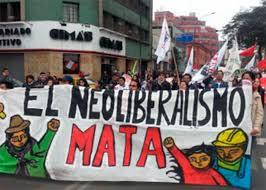Why is neoliberalism surviving?
In the first place, it is because this model reflects the interests of financial capital, that is hegemonic in the economy in the present state of the process of capital accumulation.
- Análisis

When it emerged, the neoliberal model made attractive promises. First and foremost, it was to restrain excessive State spending, diagnosed as the source of inflation. In addition, it would bring dynamism to the economy, centred on private enterprise and the market. According to the liberal discourse that accompanied it, civil society and the citizenry would be strengthened by freeing them of being hampered and oppressed by the State.
That was not what happened, but in some cases, for some time at least, inflation was controlled, although the public debt increased. When the positive effects wore out, the discourse appeared to the effect that while this was the best model, it was the only one possible in the era of globilization.
Today, while the recessive crisis has been prolonged in Europe since 2008, while this effect is extended across the whole international economy, positive aspects are no longer visible and nor is it obligatory to maintain the neoliberal model, which is the axis of the crisis at the national and international levels. The traditional political parties, conservatives and social democrats, who have taken on austerity policies -- the form taken by neoliberalism on that continent – are being chastised by the voters and every election increases the desperation of these parties.
Nowhere has the application of the severe budget adjustments -- the axis of the neoliberal models – accomplished its promises. Neither the control of public accounts and inflation, nor much less a return to economic development. Its performance is globally considered a failure and responsible for perpetuating recession in the world economy.
In Latin America this is also evident. Comparing the economies of Brazil and Argentina under anti-neoliberal governments and after the return of the neoliberal model, the result is scandalously clear in favour of the former. Look at how countries such as Ecuador, Bolivia, Brazil, have improved compared to the situation in Mexico or Peru.
So why then, in spite of the spectacular failure of neoliberalism, has this model continued to be applied in a large part of the world, including the US, Europe, Japan and the majority of the countries of Latin America, Asia and Africa?
In the first place, it is because this model reflects the interests of financial capital, that is hegemonic in the economy in the present state of the process of capital accumulation. There are strong economic interests for the preservation of this model, which only serves to increase the wealth and power of financial capital.
Secondly, because capitalism itself does not possess alternatives. At its present stage, it would be unable to return to forms of economic regulation that would avoid its being subjected to the recessive pressures of financial capital.
Thirdly, because the forces that are opposed to neoliberalism have not been able, up to now, in the great majority of countries, to understand that the fundamental struggle in the present historical period is to overcome the neoliberal model and thus be able to build a concrete alternative to this model, bringing together the necessary political and social forces.
Following its initial strong upsurge, the neoliberal model went into survival mode, a phase marked by economic recession and by a huge social crisis, as well as an immense crisis of hegemony that signals its collapse and is activating the search for alternatives to overcome it.
(Translated from Spanish for ALAI by Jordan Bishop)
- Emir Sader, Brazilian sociologist and political scientist, is the Coordinator of Public Policy with the State University of Río de Janeiro (UERJ).
08/02/2017
Del mismo autor
- Hay que derrotar políticamente a los militares brasileños 07/04/2022
- China y Trump se fortalecen 04/03/2022
- Pandemia e Ucrânia aceleram decadência da hegemonia norte-americana no mundo 28/02/2022
- Pandemia y Ucrania aceleran la decadencia de la hegemonía norteamericana en el mundo 28/02/2022
- La anti-política generó la fuerza de extrema derecha 22/02/2022
- Las responsabilidades del PT 10/02/2022
- Estados Unidos, más aislado que nunca en América Latina 03/02/2022
- Memoria y olvido en Brasil 27/01/2022
- 2022: tiempos decisivos para Brasil y Colombia 05/01/2022
- Brasil: una historia hecha de pactos de élite 18/12/2021
Clasificado en
Clasificado en:
Crisis Económica
- Geraldina Colotti 07/04/2022
- Julio C. Gambina 07/04/2022
- Rafael Bautista S. 06/04/2022
- Julio Gambina 04/04/2022
- José Ramón Cabañas Rodríguez 01/04/2022
